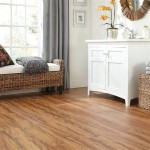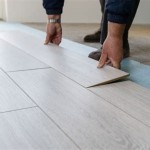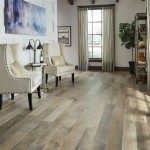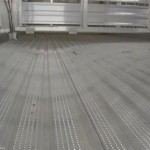Cork Laminate Flooring: A Practical and Sustainable Choice
Cork laminate flooring presents a compelling alternative to traditional flooring options, offering a blend of aesthetic appeal, functional benefits, and environmental responsibility. This type of flooring leverages the unique properties of cork to create a comfortable, durable, and sustainable surface for residential and commercial spaces.
Understanding the composition and manufacturing process of cork laminate flooring is crucial for appreciating its advantages. Unlike solid cork flooring, cork laminate utilizes a multi-layered construction. The core layer is typically composed of high-density fiberboard (HDF) or other similar engineered wood product, providing structural stability and impact resistance. A thin layer of natural cork veneer is then adhered to the top surface, imparting the characteristic look and feel of cork. This veneer is often protected by a durable wear layer, usually made of melamine or a similar resilient material, to resist scratches, stains, and wear. Finally, a backing layer is applied to enhance dimensional stability and provide moisture resistance.
The resulting laminate flooring product combines the visual warmth and tactile comfort of cork with the durability and ease of maintenance associated with laminate materials. This makes it a versatile option suitable for a wide range of applications, from living rooms and bedrooms to kitchens and offices.
Key Point 1: The Environmental Benefits of Cork
One of the most significant advantages of cork laminate flooring is its environmental sustainability. Cork is harvested from the bark of the cork oak tree (Quercus suber), primarily found in Portugal and Spain. The harvesting process does not harm the tree; the bark is carefully stripped by skilled workers every nine years, allowing the tree to regenerate its bark naturally. This renewable harvesting cycle ensures the long-term survival of the cork oak forests, which play a vital role in biodiversity conservation and carbon sequestration. Cork oak forests support a rich ecosystem, providing habitat for numerous species of plants and animals, including endangered species such as the Iberian lynx and the Iberian Imperial Eagle.
Moreover, the production of cork laminate flooring often utilizes recycled cork material, further reducing its environmental footprint. Scraps and waste generated during cork processing can be repurposed into new flooring products, minimizing waste and conserving resources. The use of water-based adhesives and low-VOC (volatile organic compound) finishes in the manufacturing process also contributes to a healthier indoor environment.
Compared to other flooring materials such as hardwood or vinyl, cork boasts a significantly lower environmental impact. Hardwood flooring requires the felling of mature trees, which can have detrimental effects on forest ecosystems. Vinyl flooring, on the other hand, is typically made from petroleum-based materials, contributing to greenhouse gas emissions and plastic waste. Cork offers a more sustainable alternative, aligning with the growing demand for eco-friendly building materials.
Furthermore, cork laminate flooring can contribute to LEED (Leadership in Energy and Environmental Design) certification for buildings. LEED is a widely recognized green building rating system that evaluates the environmental performance of buildings based on various factors, including material selection, energy efficiency, and indoor air quality. Cork flooring can help projects earn credits in categories such as Materials and Resources and Indoor Environmental Quality.
Key Point 2: Comfort and Performance Characteristics
Beyond its environmental credentials, cork laminate flooring offers a range of comfort and performance characteristics that make it a desirable choice for homeowners and businesses alike. One of its most notable features is its inherent warmth and cushioning. Cork's cellular structure contains millions of air-filled cells per cubic inch, providing excellent insulation and shock absorption. This translates to a flooring surface that is warmer to the touch than tile or laminate and more comfortable to walk on, even for extended periods.
The natural elasticity of cork also contributes to its acoustic properties. Cork laminate flooring can effectively reduce impact noise, such as footsteps and dropped objects, creating a quieter and more peaceful indoor environment. This is particularly beneficial in apartments, condominiums, and multi-story buildings where noise transmission can be a concern.
Durability is another key advantage of cork laminate flooring. The wear layer protects the cork veneer from scratches, stains, and fading, ensuring a long-lasting and aesthetically pleasing surface. While not as resistant to heavy impact or abrasion as some other flooring materials, cork laminate is generally suitable for moderate to high-traffic areas in residential and commercial settings. Regular cleaning and maintenance can further extend its lifespan.
The installation process for cork laminate flooring is typically straightforward, especially for click-lock systems. These systems feature interlocking edges that allow for easy installation without the need for adhesives or special tools. This DIY-friendly installation can save homeowners money on professional installation costs. However, proper subfloor preparation is essential to ensure a level and stable surface for the flooring. A smooth, clean, and dry subfloor will prevent unevenness and potential damage to the laminate.
Furthermore, cork laminate flooring is relatively easy to maintain. Regular sweeping or vacuuming is sufficient to remove dust and debris. For deeper cleaning, a damp mop with a mild detergent can be used. Harsh chemicals and abrasive cleaners should be avoided, as they can damage the wear layer and the cork veneer. Promptly wiping up spills will also help prevent staining and water damage.
Cork's natural antimicrobial properties also contribute to a healthier indoor environment. Cork contains suberin, a waxy substance that inhibits the growth of mold, mildew, and bacteria. This makes cork laminate flooring a suitable option for individuals with allergies or sensitivities to environmental allergens.
Key Point 3: Design Versatility and Aesthetic Appeal
Cork laminate flooring offers a wide range of design options to suit various aesthetic preferences. The cork veneer can be stained or printed to achieve different colors, patterns, and textures. This allows for customization and coordination with existing décor. Some cork laminate products mimic the appearance of wood or stone, providing the look of natural materials with the added benefits of cork's comfort and sustainability.
The natural variations in the cork veneer create a unique and organic look, adding warmth and character to any space. Cork's inherent texture also provides visual interest and tactile appeal. The combination of natural beauty and modern manufacturing techniques makes cork laminate flooring a stylish and versatile choice for contemporary and traditional interiors.
The availability of different plank sizes and formats further enhances design flexibility. Wider planks can create a more spacious and luxurious feel, while narrower planks can add a more traditional or rustic touch. The choice of edge details, such as beveled or square edges, can also influence the overall appearance of the flooring.
Cork laminate flooring can be used to create a variety of design styles, from minimalist and modern to warm and inviting. Its neutral tones and natural textures complement a wide range of colors and materials. It can be paired with wood furniture, metal accents, or colorful textiles to create a cohesive and stylish space.
Moreover, the durability of the wear layer ensures that the design remains vibrant and intact for years to come. The resistance to fading and staining helps maintain the aesthetic appeal of the flooring, even in high-traffic areas. This makes cork laminate flooring a long-term investment in the beauty and value of a home or business.
While cork laminate flooring offers numerous benefits, it's important to consider its limitations. While the wear layer provides protection against scratches and stains, it is not impervious to damage. Heavy furniture or sharp objects can still leave marks on the surface. Furthermore, cork laminate flooring is not waterproof and should not be installed in areas that are constantly exposed to moisture, such as bathrooms or laundry rooms without proper precautions. However, with appropriate care and maintenance, cork laminate flooring can provide a durable, comfortable, and sustainable flooring solution for many years.
The evolution of manufacturing technology has led to significant improvements in the performance and appearance of cork laminate flooring. Modern products offer enhanced durability, improved stain resistance, and more realistic designs. This continuous innovation ensures that cork laminate flooring remains a viable and attractive option for consumers seeking a balance of style, comfort, and sustainability.
Choosing the right cork laminate flooring involves careful consideration of several factors, including the intended use, the level of traffic, and the desired aesthetic. It is advisable to research different brands and products, compare their specifications, and read reviews from other customers. Consulting with a flooring professional can also provide valuable insights and guidance in making the best choice for a specific project.

Cork Flooring Pros And Cons Is It The Right Choice For You

A Buyers Guide And Deep Dive For Cork Flooring Icork Floor

Pros And Cons Of Cork Flooring Is It Right For You Bob Vila
:strip_icc()/101868000-671010bc56bb44eca29dd44b9fb95ffb.jpg?strip=all)
Comfortable And Earth Friendly Cork Flooring Ideas

All About Cork Flooring Atomic Ranch

Cork Flooring Opus Floors

Cork Flooring Coraopolis Covering Pittsburgh Pa

Cork Laminate Floors Coffee Color Tiles

The Benefits Of Comfort Flooring With Cork When Nature Moves In Archdaily

S Wecork
Related Posts








